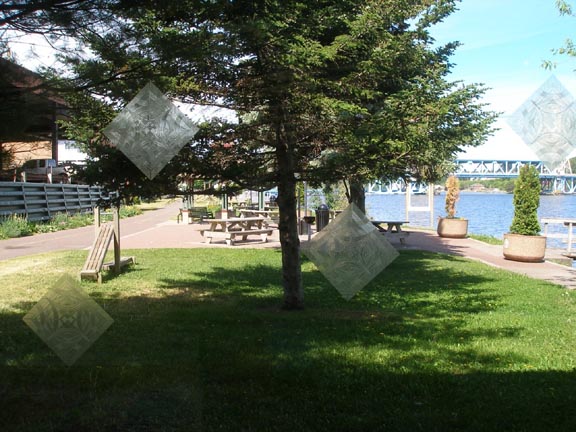Members of the Keweenaw Bay Indian Community (KBIC) drum in front of the Michigan Hall of Justice in Lansing on June 3, 2014, the occasion of a long-awaited hearing by the Michigan Court of Appeals on a contested case brought against the State of Michigan for issuing permits to Kennecott/Rio Tinto (now Lundin Mining) for the Eagle Mine Project near Big Bay, Michigan. KBIC leaders pictured here include Ogimaa (Chief) Shalifoe, left in red on the drum, and KBIC Councilman Eddy Edwards to his right in orange also on the drum. (Photo © and courtesy Jessica Koski)
BARAGA -- About 500 members of the Keweenaw Bay Indian Community (KBIC) stood united around the importance of keeping their waters clean from contamination associated with sulfide mining on June 3, 2014, at the Michigan Court of Appeals in Lansing. Oral arguments were heard involving the Eagle Mine, Michigan’s first permitted sulfide mine in the Upper Peninsula.
"This is the first time in our generation that the community as a whole came together to fight for true sovereignty and engage in spontaneous government participation. The goal of the new moving-forward Tribal Council is to bring transparency and involvement to the Anishinaabeg (the people)," said Donald Shalifoe, Sr., KBIC’s Ogimaa (Chief).
Many tribal members carpooled and traveled about eight hours to line up for the 10 a.m. Lansing hearing. KBIC’s remarkable presence overwhelmed the Michigan Hall of Justice, whose staff reported it was their largest turnout ever for a court hearing.
Some of those in the crowd in front of the Hall of Justice carry signs asking for protection of the water on the Yellow Dog Plains. (Photo © and courtesy Gene Champagne)
Tribal leaders and elders observed the hearing from within the court room, while hundreds watched and listened to the proceedings in an overflow video conferencing room. Traditional drumming and singing resounded outside the building following the hearing.
KBIC’s Vice President Carole LaPointe remarked, "It was a very educational experience for our membership and youth."
One of the youngest KBIC members, Skyler Sandman-Shelifoe, has a special seat -- a tikinaagan, meaning cradle board -- for this peaceful family gathering of all ages in Lansing. (Photo © and courtesy Jessica Koski, Skyler's Mom)
The Anishinaabeg band has opposed the Eagle Mine development, located on Treaty of 1842 ceded homeland, since it was first permitted by the Michigan Department of Environmental Quality (MDEQ) in 2006.
Unsettled concerns involve the mining regulatory process, improper permitting and inadequate assessment of impacts to the area environment, cultural resources and water quality, including groundwater contamination and the potential for perpetual acid mine drainage upstream from Lake Superior.
Donald Shalifoe, Sr., KBIC’s Ogimaa (Chief), foreground in red, addresses Keweenaw Bay Indian Community members gathered in front of the Michigan Hall of Justice in Lansing for the June 3, 2014, contested case hearing before the Michigan Court of Appeals. (Photo courtesy Keweenaw Bay Indian Community)
KBIC -- along with the Yellow Dog Watershed Preserve, National Wildlife Federation, and Huron Mountain Club -- originally brought the case forward in 2008, asserting that the Michigan Department of Environmental Quality (MDEQ) issued permits for Eagle Mine without assuring the permittee followed the criteria set in Michigan’s non-ferrous mining law, Part 632. Initially, the case was heard by an administrative judge. The case then went to Circuit Court in Ingham County, where Judge Paula Manderfield concluded that the MDEQ rightfully granted the permits. The petitioners filed an appeal, which has been in limbo, waiting for a date for the Court of Appeals to hear the case.
Tribal member Jeffery Loman said on June 3, "The hearing today is another testimony to the fact that inadequate regulation and collusion between industry and government results in endless litigation."
A sign in the crowd points out the contradiction between "Pure Michigan" (a state slogan to attract tourism) and the potential dangers to water quality posed by sulfide mining. (Photo © and courtesy Gene Champagne)
Preceding the hearing, Yellow Dog Watershed Preserve Executive Director Mindy Otto was quoted on their Web site as saying, "There are many points that prove the MDEQ should not have issued the permits. They should have taken certain things into consideration, such as the fact that under Part 632, it is required to assess the impacts to the 'affected area.' The company stated that the only affected area was everything inside the fence line at Eagle Mine. It is clear this is not true, with a plethora of impacts that have happened and continue to happen today."
One aspect of the evolving case questions what qualifies as a "place of worship" under Michigan’s sulfide mining statute. An initial ruling by Michigan Administrative Law Judge Richard Patterson recommended mitigation of impacts to an Anishinaabeg sacred place, Migi zii wa sin (Eagle Rock), but the MDEQ made a final permit decision asserting only built structures are places of worship. Since then the portal to the Eagle Mine has been constructed under Eagle Rock.
This 2012 photo shows the decline tunnel that has been constructed under Eagle Rock (tree-covered outcrop at left behind fence) to serve as the portal to the Eagle Mine. The decline tunnel is 18 feet in diameter and descends under Eagle Rock at a 13 percent grade (Every 100 feet it drops 13 feet). (Keweenaw Now file photo)
Discriminatory enforcement of Michigan law has led to substantial degradation to KBIC’s sacred site. This includes obtrusive mine facilities and a decline access ramp into the base of Eagle Rock, non-stop noise and activity, and hindered traditional access and use. Spiritually significant high places like Eagle Rock are used in solitude by the Anishinaabeg for multi-day fasting, vision quest and ceremony.
Despite the passage of the American Indian Religious Freedom Act of 1978, Native people still struggle to protect their remaining sacred places in the face of extractive development agendas.
"It is a shame that the United States of America, proudly founded upon values of religious freedom, has trouble guaranteeing this right to all of its nation’s first people," said tribal member Jessica Koski.
Gene and Carla Champagne of Concerned Citizens of Big Bay were also present in the Hall of Justice during part of the hearing.
"We were able to squeeze into a standing-room-only TV room to watch the proceedings," Gene Champagne said. "The courtroom itself was full. The appeals panel had already heard arguments about the desecration of a sacred site and were finishing up discussion on the water treatment plant."
Gene noted he was impressed by the solidarity in the gathering outside and the cautious optimism of those who had witnessed the entire hearing.
"I was moved that so many people had traveled so far to defend a fundamental constitutional, tribal, and universal right -- the freedom of religion and the right to worship and practice as we believe," he added. "It is too bad the MDEQ does not regard the constitution as relevant. Hopefully the Appeals Court will."
KBIC anticipates a decision from the Michigan Court of Appeals within six months. The Eagle Mine’s time frame for production start-up is the end of 2014.
"While the court deliberates, it is important to remember that regardless of the outcome, we are in the right for standing up for the Yellow Dog Plains," said Emily Whittaker of Big Bay, Mich., who joined KBIC members and other locally affected residents during the hearing in Lansing. "We hope the court understands their decision will have long lasting implications for this place, as well as other areas that are slated for mining."
According to KBIC, several environmental groups and many concerned citizens, the Michigan Court of Appeals ruling will be an important precedent for additional sulfide mining proposals threatening Michigan’s Upper Peninsula and waters of the Great Lakes.
Eagle Mine issues statement on Court of Appeals hearing
A recent aerial view of Eagle Mine near Big Bay, Michigan. Eagle Rock, the Anishinaabeg sacred site, is the green outcrop in the lower right quarter of the photo. (Photo courtesy Eagle Mine. Reprinted with permission.)
On June 3, Eagle Mine issued a statement noting they are confident in their own position and optimistic about the pending Appeals Court decision.
Commenting on the arguments made before the Michigan Court of Appeals on June 3, Eagle Mine General Manager Mike Welch said, "Eagle Mine appreciates the opportunity to argue the merits of the case in support of the permits granted by MDEQ and the agency's extensive review process that has withstood previous challenges over the past eight years.
"This is a testament to our team's expertise, experience and professionalism in terms of its environmental protectiveness, safety culture and commitment to the community in which we operate. We are confident the project complies with all state and federal laws and regulations for safeguarding the environment. Even more, we are extremely proud of the nearly 800 men and women that have built Eagle."
Eagle Mine's statement notes the small, high-grade deposit will produce 360 million pounds of nickel, 295 million pounds of copper and small amounts of other metals over an estimated eight-year mine life. They expect to begin operations in late 2014.





















































































































No comments:
Post a Comment